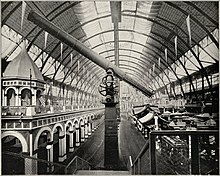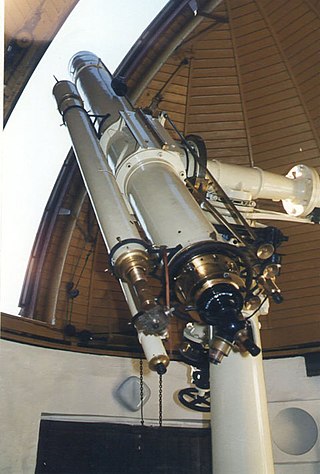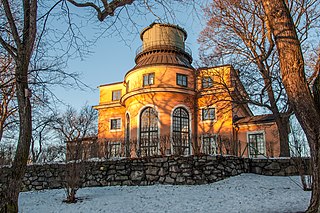
This is a list of the largest optical telescopes in North America.

This is a list of the largest optical telescopes in North America.
A list of optical telescopes located in North America by aperture.
Some of the big traditional refracting lens telescopes in North America:
| Name/Observatory | Location | Lens diameter | Focal length | Built | Comments | Image |
|---|---|---|---|---|---|---|
| Yerkes Observatory [6] | Williams Bay, Wisconsin, USA | 102 cm (40") | 19.4 m (62′) | 1897 | Largest in operation [7] | |
| James Lick telescope Lick Observatory | Mount Hamilton, California, USA | 91 cm (36") | 17.6 m | 1888 | | |
| William Thaw Telescope Allegheny Observatory | Pittsburgh, Pennsylvania, USA | 76 cm (30") | 14.1 m | 1914 | Brashear made, photographic [8] | |
| Leander McCormick Observatory | Charlottesville, Virginia, USA | 66 cm (26") | 9.9 m | 1884 | completed c. 1874, installed 1884 | |
| U.S. Naval Observatory | Foggy Bottom Washington, DC, USA moved to Northwest, Washington, D.C., 1893 | 66 cm (26") | 9.9 m | 1873 | Largest refractor in 1873. Alvan Clark & Sons mounting replaced with Warner & Swasey mounting in 1893. |  |
| Sproul Observatory | Pennsylvania, USA | 61 cm (24") | 11.0 m (36 ft) | 1911 | Currently under restoration to be re-installed in Northwest Arkansas [9] |  |
| Lowell Observatory | Arizona, USA | 61 cm (24") | 9.75 m (32 ft) | 1894 | Alvan Clark & Sons telescope |  |
Optical telescopes only
| Name / Observatory | Image Out | Image In | Aperture | First Light | Nation |
|---|---|---|---|---|---|
| Hale Telescope Palomar Obs. | |  | 200 inch 508 cm | 1949 | |
| Hooker Telescope Mount Wilson Obs. | |  | 100 inch 254 cm | 1917 | |
| McDonald Obs. 82 inch i.e. Otto Struve Telescope | |  | 82 inch 208 cm | 1939 | |
| David Dunlap Observatory |  |  | 74 inch 188 cm | 1935 | |
| Plaskett telescope Dominion Astrophysical Obs. | |  | 72 inch 182 cm | 1918 | |
| 69-inch Perkins Telescope [10] Perkins Observatory | | | 69 inch 175 cm | 1931–1964 | |
| Wyeth 61" reflector [11] Oak Ridge Observatory | | 61 inch 155 cm | 1933–2005 [12] | ||
| 60 inch Hale Mount Wilson Observatory |  | 60 inch 152.4 cm | 1908 | ||
| Name/Observatory | Aperture cm (in) | Type | Location then (Original Site) | Extant* |
|---|---|---|---|---|
| Yerkes Observatory [6] | 102 cm (40") | achromat | Williams Bay, Wisconsin, USA | 1897 |
| James Lick telescope, Lick Observatory | 91 cm (36") | achromat | Mount Hamilton, California, USA | 1888 |
| Crossley Reflector [13] | 91.4 cm(36") | reflector – glass | Lick Observatory, California, USA | 1896 |
| Harvard College Observatory | 71 cm (28") | reflector | Cambridge, Massachusetts, USA | 1889 [14] |
| McCormick Observatory | 67 cm (26.37") | achromat | Charlottesville, Virginia, USA | 1883 |
| U.S. Naval Observatory | 66 cm (26") | achromat | Washington, DC, USA | 1873 |
| Lowell Observatory | 61 cm (24") | achromat | Arizona, USA | 1896 |
| Halstead Observatory | 58.4 cm (23") | achromat | Princeton, USA | 1881 |
| Chamberlin Observatory | 50 cm (20") | achromat | Colorado, USA | 1891 |
| 18½-in Dearborn Observatory Refractor | 47 cm (18.5") | achromat | Chicago (1862–1893), Evanston, Illinois (1893), USA | 1862 |
| Flower Observatory | 46 cm (18") | achromat | Philadelphia, USA | 1896 |
| Harvard Great Refractor, Harvard College Observatory [15] | 38 cm (15") | achromat | Cambridge, Massachusetts, USA | 1847 |
| Wellesley College Whitin Observatory 12-inch Fitz Jacob Campbell's 12 inch refractor [16] | 30 cm (12") | achromat | Massachusetts, USA New York, USA | 1900 1852 |
| University of Illinois Observatory | 30 cm (12") | achromat | Urbana, Illinois, USA | 1896 |
| Merz und Mahler (Mitchell cupola), Cincinnati Observatory | 28 cm (11") | achromat | Cincinnati, Ohio, USA | 1843 |
| Fraunhofer Refractor, United States Naval Observatory (Foggy Bottom) | 24.4 cm (9.6") | achromat | Foggy Bottom, D.C., USA | 1844 [17] |
| Wesleyan University 6-inch Lerebours refractor [18] | 15.24 cm (6") | achromat | Connecticut, USA | 1836 [18] [19] |
| Utzschneider & Fraunhofer Comet Seeker [20] | 10.2 cm (4") | acrhomat | Foggy Bottom, D.C., USA | 1843 |
Some of the largest at observatories:
| Name/Observatory | Aperture cm (in) | Type | Location then (Original Site) | Extant* |
|---|---|---|---|---|
| Harvard Great Refractor, Harvard College Observatory [15] | 38 cm (15") | achromat | Cambridge, Massachusetts, USA | 1847 |
| Merz und Mahler (Mitchell cupola), Cincinnati Observatory | 28 cm (11") | achromat | Cincinnati, Ohio, USA | 1843 |
| West Point Observatory 9.75 inch Fitz equatorial | 24.77 cm (9.75") | achromat | West Point, USA | 1839 [21] |
| Fraunhofer Refractor, United States Naval Observatory (Foggy Bottom) | 24.4 cm (9.6") | achromat | Foggy Bottom, D.C., USA | 1844 [17] |
| Wesleyan University 6-inch Lerebours refractor [18] | 15.24 cm (6") | achromat | Connecticut, USA | 1836 |
| Yale Dollond 5-inch, Yale College Observatory | 12.7 cm (5") | achromat | New Haven, Connecticut, USA | 1828 [21] |
| Utzschneider & Fraunhofer Comet Seeker [20] | 10.2 cm (4") | acrhomat | Foggy Bottom, D.C., USA | 1843 |

Yerkes Observatory is an astronomical observatory located in Williams Bay, Wisconsin, United States. The observatory was operated by the University of Chicago Department of Astronomy and Astrophysics from its founding in 1897 until 2018. Ownership was transferred to the non-profit Yerkes Future Foundation (YFF) in May 2020, which began millions of dollars of restoration and renovation of the historic building and grounds. Yerkes re-opened for public tours and programming in May 2022. The April 2024 issue of National Geographic magazine featured a story about the Observatory and ongoing work to restore it to relevance for astronomy, public science engagement and exploring big ideas through art, science, culture and landscape. The observatory offers tickets to programs and tours on its website.

The Nice Observatory is an astronomical observatory located in Nice, France on the summit of Mount Gros. The observatory was founded in 1879, by the banker Raphaël Bischoffsheim. The architect was Charles Garnier, and Gustave Eiffel designed the main dome.

The history of the telescope can be traced to before the invention of the earliest known telescope, which appeared in 1608 in the Netherlands, when a patent was submitted by Hans Lippershey, an eyeglass maker. Although Lippershey did not receive his patent, news of the invention soon spread across Europe. The design of these early refracting telescopes consisted of a convex objective lens and a concave eyepiece. Galileo improved on this design the following year and applied it to astronomy. In 1611, Johannes Kepler described how a far more useful telescope could be made with a convex objective lens and a convex eyepiece lens. By 1655, astronomers such as Christiaan Huygens were building powerful but unwieldy Keplerian telescopes with compound eyepieces.

A refracting telescope is a type of optical telescope that uses a lens as its objective to form an image. The refracting telescope design was originally used in spyglasses and astronomical telescopes but is also used for long-focus camera lenses. Although large refracting telescopes were very popular in the second half of the 19th century, for most research purposes, the refracting telescope has been superseded by the reflecting telescope, which allows larger apertures. A refractor's magnification is calculated by dividing the focal length of the objective lens by that of the eyepiece.

The Stockholm Observatory is an astronomical observatory and institution in Stockholm, Sweden, founded in the 18th century and today part of Stockholm University. In 1931, the new Stockholm Observatory, nicknamed "Saltis", was inaugurated on the Karlsbaderberget at Saltsjöbaden, near Stockholm, and operated until 2001.

Hamburg Observatory is an astronomical observatory located in the Bergedorf borough of the city of Hamburg in northern Germany. It is owned and operated by the University of Hamburg, Germany since 1968, although it was founded in 1825 by the City of Hamburg and moved to its present location in 1912. It has operated telescopes at Bergedorf, at two previous locations in Hamburg, at other observatories around the world, and it has also supported space missions.

A telescope is a device used to observe distant objects by their emission, absorption, or reflection of electromagnetic radiation. Originally, it was an optical instrument using lenses, curved mirrors, or a combination of both to observe distant objects – an optical telescope. Nowadays, the word "telescope" is defined as a wide range of instruments capable of detecting different regions of the electromagnetic spectrum, and in some cases other types of detectors.
The following timeline lists the significant events in the invention and development of the telescope.

The Dearborn Observatory is an astronomical observatory located on the Evanston campus of Northwestern University. The observatory was originally constructed in 1888, through an agreement between the university and the Chicago Astronomical Society. In the summer of 1939, Dearborn Observatory had to be moved to make way for the construction of the Technological Institute.

McMillin Observatory was an astronomical observatory built around 1895 on the campus of Ohio State University. Named after Emerson McMillin and operated by the university, the observatory closed in 1968 and its telescope later moved to Ballreich Observatory. The observatory was equipped with photographic cameras, a filar micrometer, and a custom Brashear spectroscope. The observatory had two main focuses, education and at least one astronomic scientific research study focus.

Great refractor refers to a large telescope with a lens, usually the largest refractor at an observatory with an equatorial mount. The preeminence and success of this style in observational astronomy defines an era in modern telescopy in the 19th and early 20th century. Great refractors were large refracting telescopes using achromatic lenses. They were often the largest in the world, or largest in a region. Despite typical designs having smaller apertures than reflectors, great refractors offered a number of advantages and were popular for astronomy. It was also popular to exhibit large refractors at international exhibits, and examples of this include the Trophy Telescope at the 1851 Great Exhibition, and the Yerkes Great Refractor at the 1893 World's Fair in Chicago.

Yerkes 41-inch reflector is a 40-inch aperture (101.6 cm) reflecting telescope at the Yerkes Observatory, that was completed in 1968. It is known as the 41 inch to avoid confusion with a 40 inch refractor at the observatory. Optically it is a Ritchey–Chrétien design, and the main mirror uses low expansion glass. The telescope was used as a testbed for an adaptive optics system in the 1990s.

Potsdam Great Refractor is an historic astronomical telescope in an observatory in Potsdam, Germany.